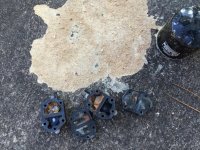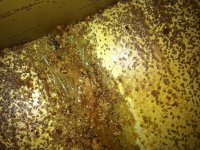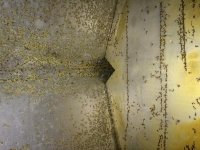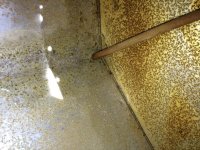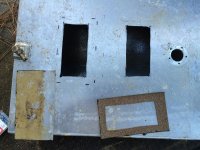I have an old 1982 Wellcraft 18 Fisherman CC that I replaced the original fuel tank in 2011 (had an aluminum tank fabricated in Houston). I also repowered with a Tohatsu 115 TLDI in 2012. I use ethanol free gas I get from Sulphur LA and that's all this motor has ever seen.
I didn't use the boat last year much and had left the fuel in there (thinking that ethanol free gas doesn't break down as fast as E10 fuel). At the beginning of this summer upon getting it ready I added 10 or so gallons of newer gas (still 6+ months old but looked good going in) as well as a half a bottle of Startron fuel additive (don't recall adding it previously but may have).
My two fuel pumps were taken out by old gas that I believe had dried over the course of 5 years due to a fuel pickup tube not going straight down like it should but angled so it had a 4 inch (or more) gap between the crevice of the bottom of the tank and it's tip. I've provided pictures of after bending back to where it should be, there's less than an inch gap now.
This tank has three compartments and to be able to clean it I had to cut out 3 access ports to be able to clean it and discover the fuel pickup tube issue. I know the EPA/GOV/COASTIES would frown on this but I've talked to knowledgeable folks and they say it's ok as long as you use a gasket (I used a cork gasket like what was on the fuel sender). I put sheet metal screws (claims they are steel as I couldn't find aluminum ones to use) about 1 inch apart all around the access panels.
My question is do you guys think I'm crazy for doing this and is it unsafe? My new fuel pumps come in today and I hope that's all that is affected. I've had this happen before and that's all they replaced. I won't rehash that here.
Following are pictures of what I'm seeing. One pictures is the contents of the external fuel filter compared to what came through on the fuel pumps, two pictures are of the inside of the fuel tank after evacuating the gas in it and cleaning the tank (they have scores on the inside of the tank that I guess was some kind of chemical reaction between the E0 gas and aluminum) and then some pictures of the outside of the tank with the access ports I cut before screwing them in.
Please provide input if you have thoughts.
I didn't use the boat last year much and had left the fuel in there (thinking that ethanol free gas doesn't break down as fast as E10 fuel). At the beginning of this summer upon getting it ready I added 10 or so gallons of newer gas (still 6+ months old but looked good going in) as well as a half a bottle of Startron fuel additive (don't recall adding it previously but may have).
My two fuel pumps were taken out by old gas that I believe had dried over the course of 5 years due to a fuel pickup tube not going straight down like it should but angled so it had a 4 inch (or more) gap between the crevice of the bottom of the tank and it's tip. I've provided pictures of after bending back to where it should be, there's less than an inch gap now.
This tank has three compartments and to be able to clean it I had to cut out 3 access ports to be able to clean it and discover the fuel pickup tube issue. I know the EPA/GOV/COASTIES would frown on this but I've talked to knowledgeable folks and they say it's ok as long as you use a gasket (I used a cork gasket like what was on the fuel sender). I put sheet metal screws (claims they are steel as I couldn't find aluminum ones to use) about 1 inch apart all around the access panels.
My question is do you guys think I'm crazy for doing this and is it unsafe? My new fuel pumps come in today and I hope that's all that is affected. I've had this happen before and that's all they replaced. I won't rehash that here.
Following are pictures of what I'm seeing. One pictures is the contents of the external fuel filter compared to what came through on the fuel pumps, two pictures are of the inside of the fuel tank after evacuating the gas in it and cleaning the tank (they have scores on the inside of the tank that I guess was some kind of chemical reaction between the E0 gas and aluminum) and then some pictures of the outside of the tank with the access ports I cut before screwing them in.
Please provide input if you have thoughts.

